What's the big fuss with Synthetic Oil? It flows better Hot & Cold, Bonds better and lasts longer:
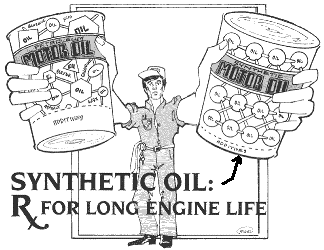
Synthetic oil doesn't contain the naturally occurring chemicals that break down at high temperatures. It is also manufactured without many of the chemical compositions that contribute to oil oxidation and sludge buildup. Synthetic oil can tolerate temperatures that would burn up petroleum-based oils. Synthetic oil is more slippery causing less friction. Less friction and lower temps means more horsepower and torque. See the Video Dyno Comparison with Royal Purple with no break in period from HorsepowerTV: ClickMe.
Since synthetics are more durable, oil changes are not needed as often, and this fact partially negates the cost disadvantage of synthetics. Petroleum-based oils generally require replacement every 3,000 to 6,000 miles, depending on service use. Synthetic oils can easily offer double the service life as their chemical composition does not break down over time. Amsoil Synthetic Oil may go as high as 25,000 miles or 1 year, ClickMe to see this information Video from Amsoil.
Synthetic oil does not lose its ability to flow well in cold weather, so it is preferred for cars driven in cold climates as start up without oil flow from standard oils causes wear. Synthetic oils also bond to parts better than standard oils giving that extra protection upon start up. To see a great comparison pour test in cold check out this VIDEO 45 secs in. Synthetic oils also perform better and more consistently at high temperatures, and are frequently recommended for high-performance engines.
ClickMe to see a great video on oil viscosity from Driven Oil
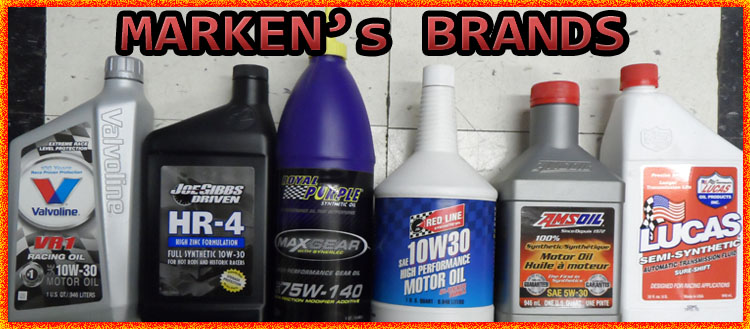
Marken Performance Stocks the Following Brands, Click on Your Favorite for More Info and Product Search: Amsoil, Royal Purple, RedLine, Mobile1, Lucas, Valvoline, Edelbrock, Motul and Joe Gibbs Driven Racing Oil
 Disadvantage of Synthetic Oil: 1) Price , 2) Synthetic oil does not hold lead in the suspension of the oil. This is a problem with older car engines that still run leaded gasoline to run in their engines, 3) Synthetic oil is not recommended for rotary type engines. Myth: “synthetic oil is not suitable for new engines, due to its low friction. This is important for drivers who wish to use synthetic oil on a new car with an engine that according to manufacturer specifications must be "broken in." In cases such as these, the driver should change to synthetic oil only after the vehicle has been broken in using traditional motor oil.” You can start using synthetic oil in new vehicles at any time, even in brand new vehicles. In fact, synthetic oil is original equipment on many brands. There is obviously not much advantage until your first oil change is due. A break in period is not as crucial as it was in the past.
Disadvantage of Synthetic Oil: 1) Price , 2) Synthetic oil does not hold lead in the suspension of the oil. This is a problem with older car engines that still run leaded gasoline to run in their engines, 3) Synthetic oil is not recommended for rotary type engines. Myth: “synthetic oil is not suitable for new engines, due to its low friction. This is important for drivers who wish to use synthetic oil on a new car with an engine that according to manufacturer specifications must be "broken in." In cases such as these, the driver should change to synthetic oil only after the vehicle has been broken in using traditional motor oil.” You can start using synthetic oil in new vehicles at any time, even in brand new vehicles. In fact, synthetic oil is original equipment on many brands. There is obviously not much advantage until your first oil change is due. A break in period is not as crucial as it was in the past.
![]()
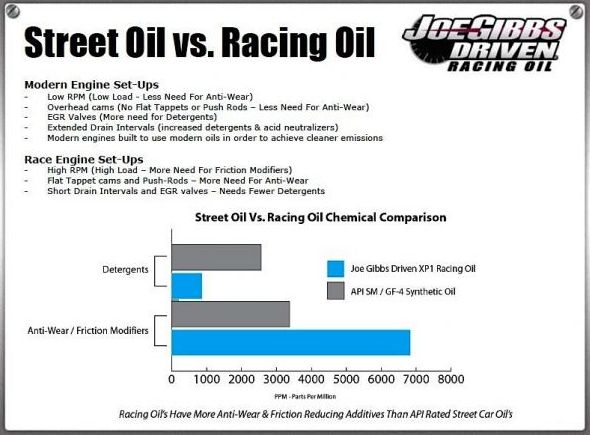 The difference between racing oil and street oil is largely characterized by the base oil chemistry and various additive packages specified by engine manufacturers. Additive packages contribute multiple levels of lubrication efficiency and protection — including anti-wear, friction reduction, rust and corrosion resistance and detergent and dispersant qualities — that help keep engine internals clean and functioning properly.
The difference between racing oil and street oil is largely characterized by the base oil chemistry and various additive packages specified by engine manufacturers. Additive packages contribute multiple levels of lubrication efficiency and protection — including anti-wear, friction reduction, rust and corrosion resistance and detergent and dispersant qualities — that help keep engine internals clean and functioning properly.
“Racing oil is more heavily fortified with additive systems to give the performance to protect the engine,” sums up Mark Negast, technical director at Lucas Oil Products. “Still the same additive systems, just higher concentrations.”
The chemistry restrictions set by API originally targeted only phosphorus — which can be harmful to catalytic converters — and currently stand at 800ppm (parts per million). Phosphorus is typically only found in anti-wear additives, so a restriction on total phosphorus puts a restriction on the total additive.
“ZDDP additives with faster activation rates are more suitable for racing and high performance street engines with challenging friction characteristics, such as flat tappets or new engines undergoing break-in,” says Speed. A ‘60s era muscle car engine with flat tappet lifters requires more ZDDP additives to protect the sliding friction between the lifters and the camshaft than a more modern engine with roller lifters.
“For higher rpm and horsepower, you might see lower concentrations of calcium,” echoes Negast. “Typically what happens is the calcium competes for area surface with the zinc and phosphorus. In NASCAR and IndyCar, you’ll see a reduction in calcium detergents because they’re not necessary. In NHRA, you don’t need detergent at all, just wear protection.”
For more detailed info read this article: ClickMe
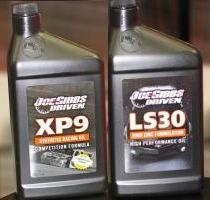 The new LS30 5W-30 synthetic oil from Joe Gibbs Driven: “It’s one of the first of its kind,” says Lake Speed Jr., a certified lubrication specialist at Joe Gibbs Driven. “It’s developed specially from mPAO base-stock technology that provides a higher viscosity index.” Formulated for high-performance LS engines, the LS30 is rated at 5W-30 but has the effect of higher 15W-40 oil. This oil also has a higher zinc content for anti-wear protection and defends against moisture drawn into the engine by modern ethanol-blended fuels. Other Joe Gibbs Driven formulas are designed specifically for old-school musclecars, air-cooled engines, high-performance Ford modular engines, motorcycles, high-revving imports and marine engines. For racers, there’s the new XP9 which provides high-temperature and high-shear protection. Racers normally running 20W-50 can drop down to XP9, which is typical of a 10W-40 oil. XP9 is compatible with methanol and high-octane race fuels. A conventional oil can handle temperatures up to 160 degrees while synthetics can withstand up to 290 degrees.
The new LS30 5W-30 synthetic oil from Joe Gibbs Driven: “It’s one of the first of its kind,” says Lake Speed Jr., a certified lubrication specialist at Joe Gibbs Driven. “It’s developed specially from mPAO base-stock technology that provides a higher viscosity index.” Formulated for high-performance LS engines, the LS30 is rated at 5W-30 but has the effect of higher 15W-40 oil. This oil also has a higher zinc content for anti-wear protection and defends against moisture drawn into the engine by modern ethanol-blended fuels. Other Joe Gibbs Driven formulas are designed specifically for old-school musclecars, air-cooled engines, high-performance Ford modular engines, motorcycles, high-revving imports and marine engines. For racers, there’s the new XP9 which provides high-temperature and high-shear protection. Racers normally running 20W-50 can drop down to XP9, which is typical of a 10W-40 oil. XP9 is compatible with methanol and high-octane race fuels. A conventional oil can handle temperatures up to 160 degrees while synthetics can withstand up to 290 degrees.
![]()
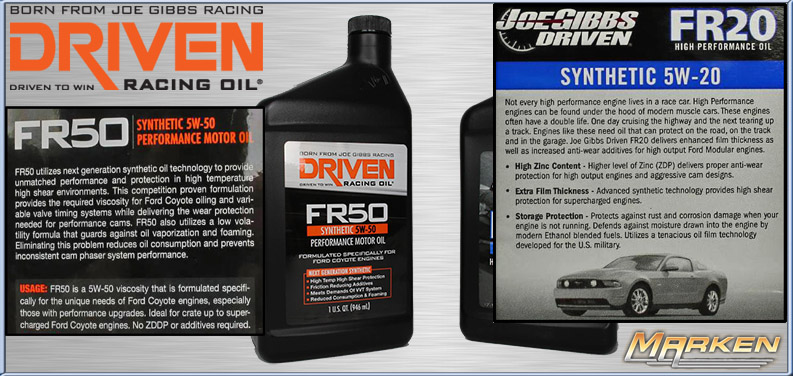
0 Weight Oils:
Auto engineers have said they see no correlation between today's lightweight "0W-" motor oils, designed to reduce friction and save gas, and excessive oil consumption. But in actual experience, both the prevalence of such lightweight oils and the propensity of more engines to consume oil seem to be moving in tandem. And the test cars that have had this problem have all used such lightweight synthetic oils. The latest car drinking oil is our $105,000 2012 Porsche Panamera, which is consuming a quart of 0W-40 motor oil about every 2,000 miles. With a 10,000 mile oil change interval, that's five quarts of synthetic oil (at about $8 per) in between oil changes. Several of our drivers got caught out by low oil warning lights and went searching for this obscure lubricant at night while out on the town. And trust us, not every corner convenience store carries 0W-40-weight motor oil. When we talked to Porsche about this, they said this usage was within spec. But we think somebody who bought a $100,000 car probably expects better. And the Porsche is not the most egregious example.
The 2008 Volkswagen Eos used a quart of equally expensive 0W-20 motor oil every 1,200 miles (accumulating black soot on the rear bumper above the tailpipe the whole way). After several trips back to the local Volkswagen dealer to document the problem, I was told that the VW spec for this engine was, exactly a quart every 1,200 miles. Since I couldn't prove it was using more than that, VW wouldn't help. That car also specified a 10,000 mile oil-change interval, for regular maintenance. By then, all the oil in the sump had been replaced twice.
Even Japanese cars known for their reliability have lately been burning oil. When I took our 2012 Subaru Impreza to Boston for a weekend, it dropped down a quart on my way back, prompting a late-night search for more 0W-20 weight oil.
According to Driven Racing Oil, “The reasons for this consumption are not mechanical, such as stuck rings or loose clearances. The reason for this “vanishing oil” is due to a technical term that also starts with a “v”—volatility.” Typically, motor oils featuring lighter base oils evaporate more quickly at high oil temperatures.” Check your oil more often with 0W__ Oils and don't get too pissed!
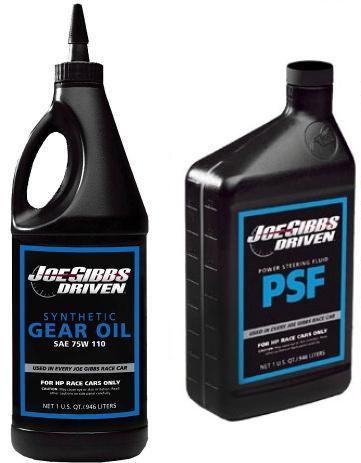
Joe Gibbs Driven also offers a full line of engine and vehicle lubricants, including synthetic gear oil, an ultra-lightweight qualifying gear oil, transmission fluids, power-steering fluid, chassis grease, engine break-in oil and engine assembly grease. These base stocks offer a viscosity index about twice that of conventional oil and about 33 percent better than typical synthetics based on regular PAO base stocks. “You can use a lighter fluid yet maintain protection with better efficiency.” Joe Gibbs Driven 75W-110 Gear Oil can reduce operating temperatures in the rear end up to 15 degrees. It can be used in all types rear ends and is available by the case, in 2.5-gallon jugs or 54-gallon drums. The PSF is a full synthetic formula that provides thermal stability to help prevent a pressure drop when temperatures increase. It also offers high-temperature foam resistance for better cooling.
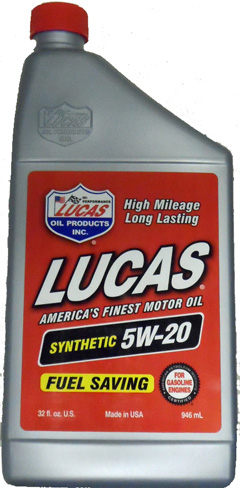
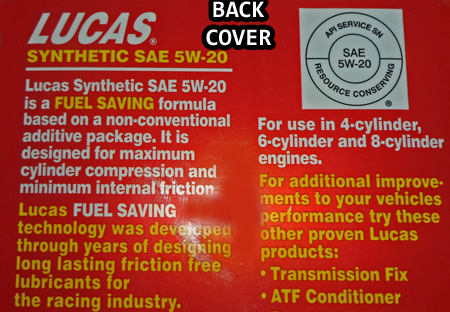
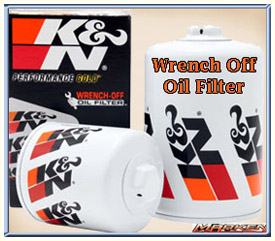
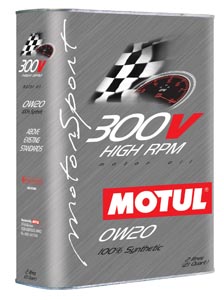
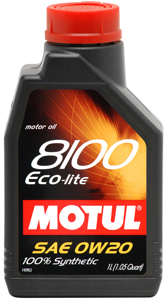
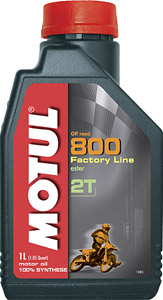
News
- Mar 26 2019 EBC New RP-1 Brake Pads for Racing
- Mar 11 2019 Bushwacker DRT Style™ Fender Flares
- Feb 23 2019 Flowmaster Cat-Back 717889 fits 2019 RAM 1500 Hemi
- Feb 11 2019 Optima Yellowtop Rectangle Battery # 9048-148, H6 Group 48
- Jan 18 2019 Holley New Larger EFI Pro Dash
- Jan 08 2019 Lucas Oil Low Viscosity Stabilizer #11097 + #11096 Intake Cleaner for Gasoline Direct Injection Engines
- May 05 2018 Thermo-Tech Rogue Series T3, T4 Turbo Cover
- Apr 30 2018 Holley’s Mid-Mount Kit # 20-200 for LT Swap, with accessories
- Apr 27 2018 SCT BDX Performance Programmer + Monitor + Adjustments
- Apr 23 2018 ReadyLift 7 inch Lift for 2014_UP Chevy 1500


You must login to post comments.